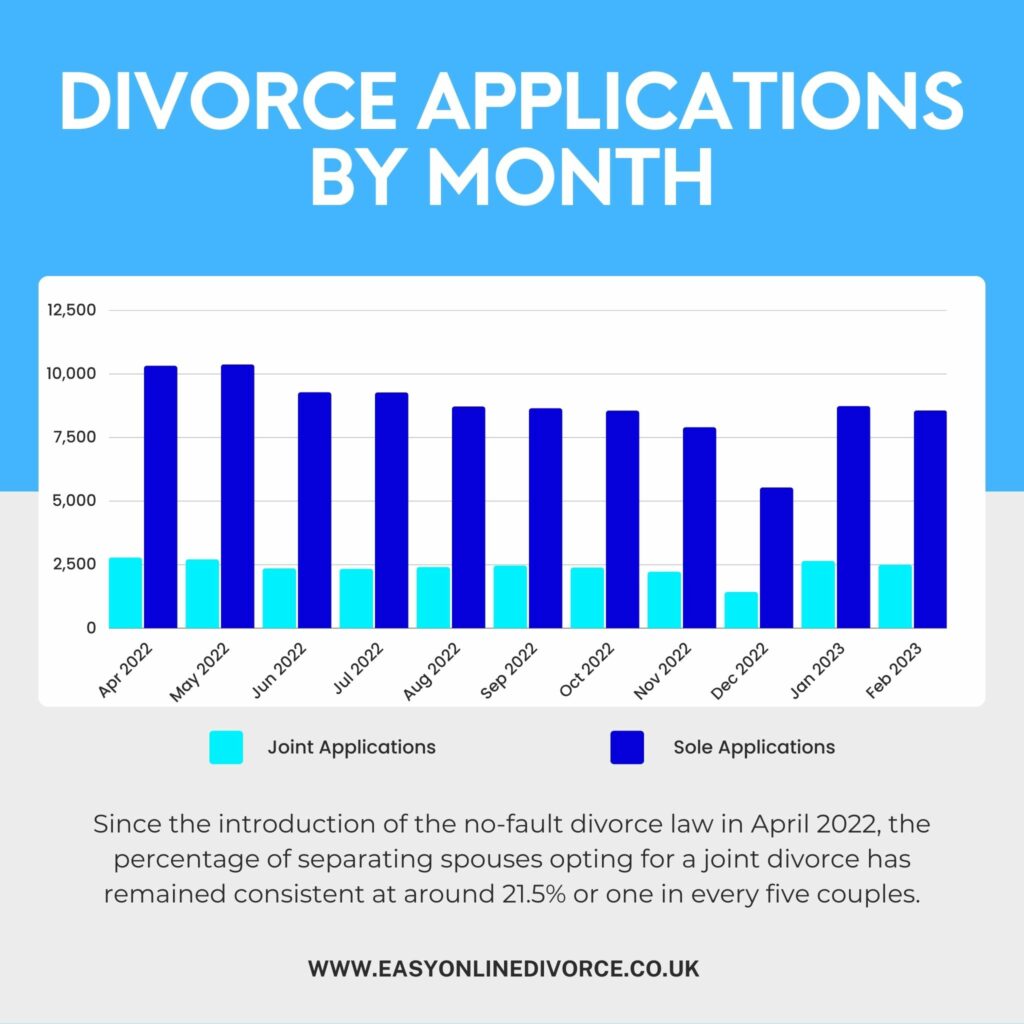The new no-fault divorce law that came in on the 6th of April 2022, allows couples to apply for their divorce jointly for the first time. Under the previous rules, one party had to be the applicant, and the other had to be the respondent. Now, both parties can be the applicant in their divorce.
Legally, there’s no difference if you file for divorce individually or apply for divorce jointly as a couple, and the end result is the same.
Ultimately, whether you should file for divorce jointly or as an individual comes down to whether you feel it is important to end your marriage together. We can’t help you with that question, but what we can do is offer some practical considerations.
How many separating couples go for a joint divorce?
Of the 121,880 divorce applications filed since the introduction of the no-fault divorce law in April 2022, 26,174 couples opted for a joint divorce. This equates to 21.5% of all divorcing couples divorcing jointly or one in every five couples.
The table below shows that the percentage has been consistent each month since the ability to file jointly began.

The pros and cons of individual and joint divorces
The joint divorce filing process is more complex. Although this doesn’t matter if you’re using a company like Easy Online Divorce to manage your joint divorce for you, it might be a factor if you’re applying for a joint divorce yourself.
The individual divorce process is straightforward and hasn’t really changed with the new laws. Some terminology has changed, and some timelines are longer, but the process itself is fundamentally the same.
The applicant files for the divorce, and then a few weeks later, the spouse (the respondent) receives the divorce papers along with a document called the acknowledgement of service (AOS). The AOS confirms to the court that you are aware of the divorce proceedings.
Once the respondent has acknowledged the service, the applicant is left to manage the rest of the divorce process. The applicant applies for the conditional order (previously known as the decree nisi). Once that is granted, there’s a waiting period before you can finalise your divorce and receive the final order (previously the decree absolute).
The joint process is more complex than the individual divorce process because it requires collaboration and coordination throughout the divorce process.
If we look back at the individual process, the only touchpoint is when the respondent receives the acknowledgement of service, but there is collaboration throughout the joint application process that will require prolonged communication with your spouse.
The difference between the individual and joint divorce process
In the joint application, applicant one starts the divorce by entering their details. Then, applicant two receives applicant one’s application and enters their own details. This is then sent back to applicant one, who checks applicant two’s details and submits the application to the court.
There is no need to acknowledge the service because both parties were involved in the application. The process will now enter a mandatory 20-week reflection period, which is the same as the individual divorce.
Once 20 weeks have passed, the couple can apply for the conditional order.
With an individual filing, one party applies for the conditional order. Now, both parties have to apply for the conditional order. If your spouse forgets or changes their mind, the divorce won’t continue.
The court recognises that even amicable splits can turn sour, so it is possible to transfer to an individual process if needed.
Once the court grants the conditional order and the six-week cooling-off period has passed, you both apply for the final order to end your marriage. From start to finish, a divorce under the new no-fault law takes around eight months.
The joint process is more complex and requires more communication with your spouse than the individual one. The description above might help you decide whether a joint final process is right for you or not.
Length of separation as a deciding factor
How long you’ve been separated might also be a deciding factor. If you’ve been apart for quite some time and both moved on with your lives, you might not want to spend more time with each other to process your divorce. If you want to avoid doing that, the individual process is probably better. On the other hand, a joint filing might be a good solution if you’ve been apart for some time but still have finances to deal with because it offers a gentle way to start moving towards and processing your financial settlement.
What if you’ve already split your finances and are simply looking for a clean break agreement? In that case, an individual filing may work just as well because a clean break order requires less conversation and collaboration.
In summary, if you’ve been apart for some time and want a low-contact divorce, then the individual filing process is probably the right choice for you. However, if you’re approaching divorce more holistically – perhaps as a reflection of how you started your marriage, then a couple might decide that a joint filing is right for them. Just be aware that a joint divorce filing requires collaboration and communication throughout the divorce process, which will take seven to eight months under the new, no-fault divorce laws.
A better alternative to a joint divorce
A potentially better alternative to a jointly filed divorce is a couple’s divorce. With a couple’s divorce, both parties are involved in the process, but one is the applicant, and the other is the respondent. Rather than having to communicate with each other, your divorce provider acts as a conduit between the two of you, minimising communication and often conflict.
Our couples divorce service is the ideal solution for couples who both want to be involved in the divorce process but want to avoid working closely together. It is also less expensive than hiring two different solicitors and tends to be quicker and with less friction because our aim is to get you both through your divorce as quickly as possible.
If you have any questions about this article or divorce in general, you can email or call us on 0204 530 8101.















